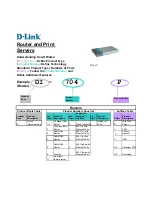
Falcon R-Class | User Guide
320
DNS
DNS is an acronym for Domain Name System. It stores and associates many types of information with
domain names. Most importantly, DNS translates human-friendly domain names and computer
hostnames into computer-friendly IP addresses. For example, the domain name www.example.com
might translate to 192.168.0.1.
DoS
DoS is an acronym for Denial of Service. In a denial-of-service (DoS) attack, an attacker attempts to
prevent legitimate users from accessing information or services. By targeting at network sites or
network connection, an attacker may be able to prevent network users from accessing email, web
sites, online accounts (banking, etc.), or other services that rely on the affected computer.
Dotted Decimal Notation
Dotted Decimal Notation refers to a method of writing IP addresses using decimal numbers and dots
as separators between octets. An IPv4 dotted decimal address has the form x.y.z.w, where x, y, z,
and w are decimal numbers between 0 and 255.
Drop Precedence Level
Every incoming frame is classified to a Drop Precedence Level (DP level), which is used throughout
the device for providing congestion control guarantees to the frame according to what was
configured for that specific DP level. A DP level of 0 (zero) corresponds to 'Committed' (Green) frames
and a DP level of 1 or higher corresponds to 'Discard Eligible' (Yellow) frames.
DSCP
DSCP is an acronym for Differentiated Services Code Point. It is a field in the header of IP packets for
packet classification purposes.
EEE
EEE is an abbreviation for Energy Efficient Ethernet defined in IEEE 802.3az.
EPS
EPS is an abbreviation for Ethernet Protection Switching defined in ITU/T G.8031.
Ethernet Type
Ethernet Type, or EtherType, is a field in the Ethernet MAC header, defined by the Ethernet
networking standard. It is used to indicate which protocol is being transported in an Ethernet frame.
FTP
FTP is an acronym for File Transfer Protocol. It is a transfer protocol that uses the Transmission
Control Protocol (TCP) and provides file writing and reading. It also provides directory service and
security features.
Fast Leave
Multicast snooping Fast Leave processing allows the switch to remove an interface from the
forwarding-table entry without first sending out group specific queries to the interface. The VLAN
interface is pruned from the multicast tree for the multicast group specified in the original leave














































